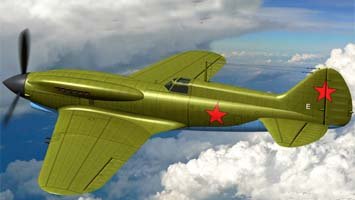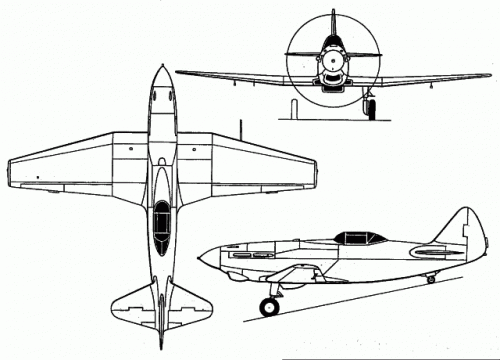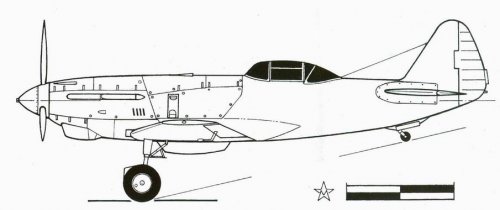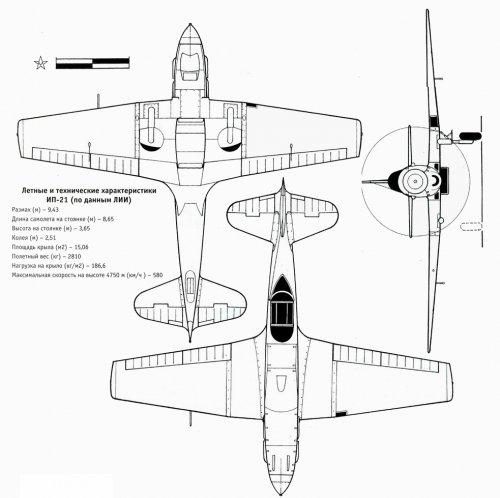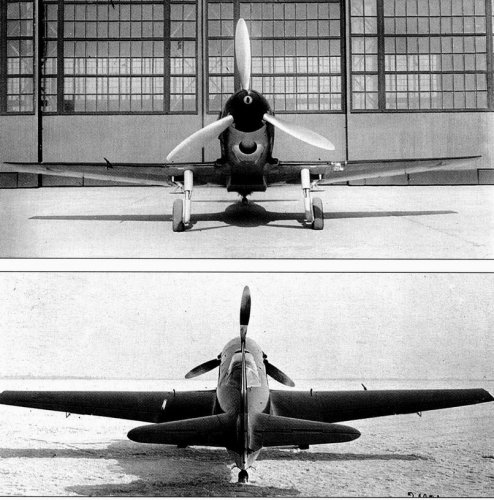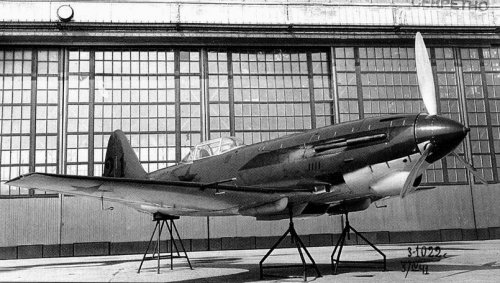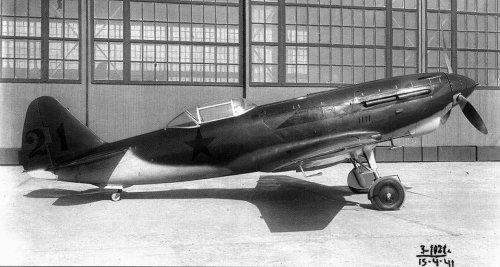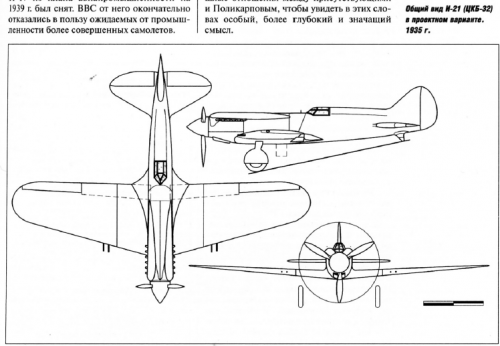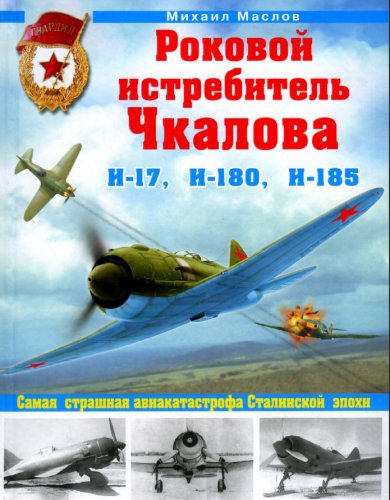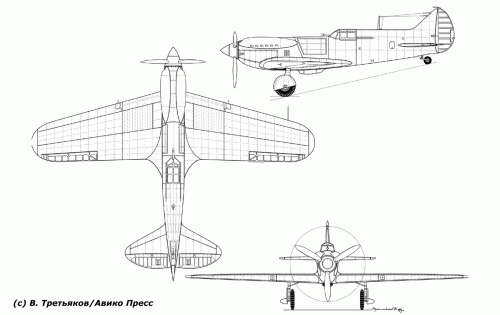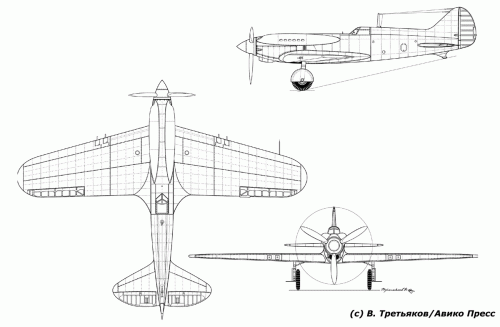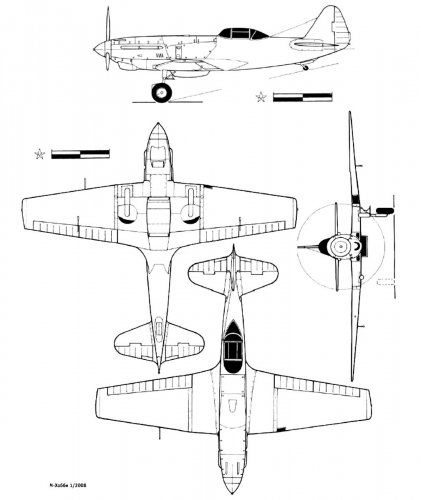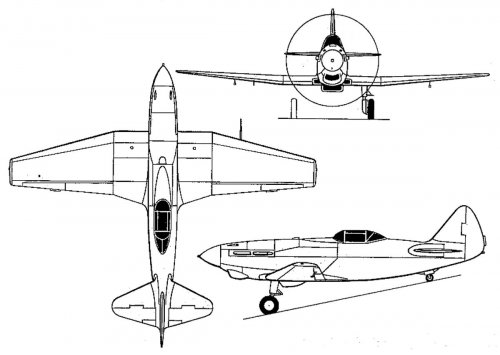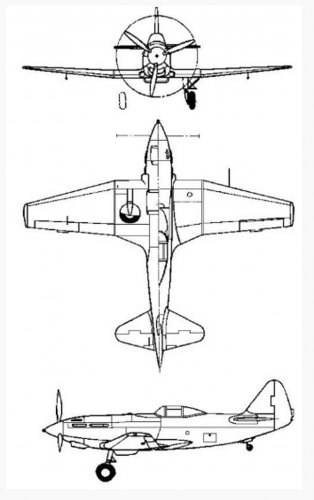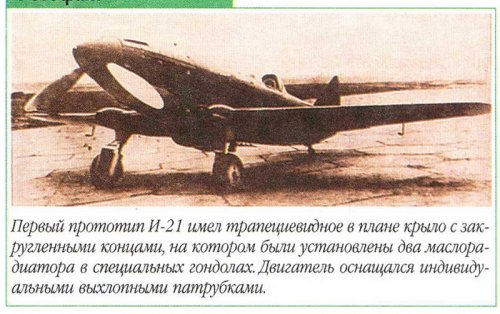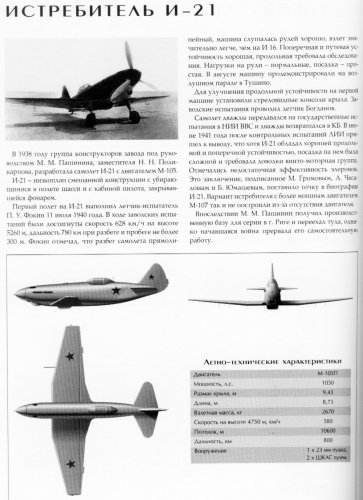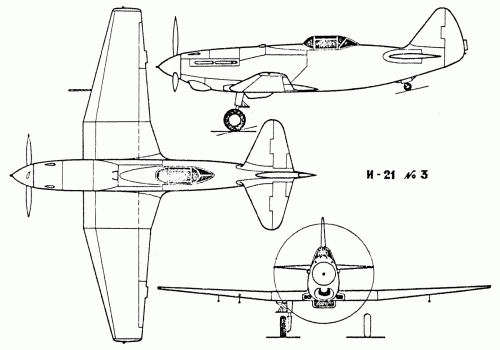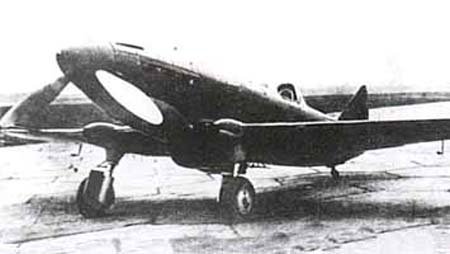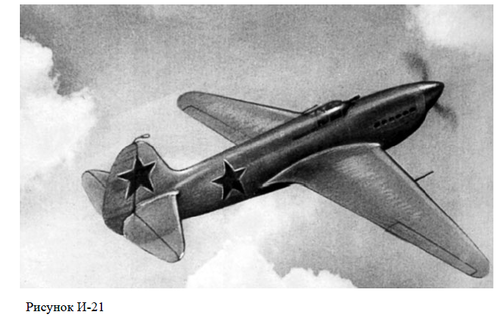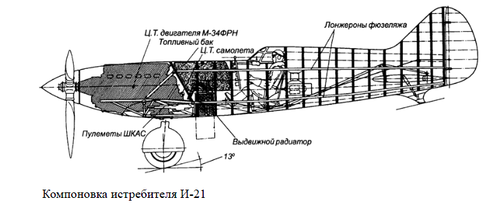You are using an out of date browser. It may not display this or other websites correctly.
You should upgrade or use an alternative browser.
You should upgrade or use an alternative browser.
Ilyushin I-21 Fighter
- Thread starter airman
- Start date
- Joined
- 25 July 2007
- Messages
- 4,299
- Reaction score
- 4,197
A few more specs:
Span 10m, length 8.37m, height 8.37m, area 3.30m, weight (empty) 1680 kg, weight (T/O) 2125 kg, fuel 150L, powerplant Mikulin M-34FRN*, ceiling 12000m, armament 2 x 20mm ShVAK.
[* 46.66 L, FRN = Forsirovanniy/Reduktor/Nagnetatel' or boosted/reduction gear/supercharged, steam-and-water cooled?]
Span 10m, length 8.37m, height 8.37m, area 3.30m, weight (empty) 1680 kg, weight (T/O) 2125 kg, fuel 150L, powerplant Mikulin M-34FRN*, ceiling 12000m, armament 2 x 20mm ShVAK.
[* 46.66 L, FRN = Forsirovanniy/Reduktor/Nagnetatel' or boosted/reduction gear/supercharged, steam-and-water cooled?]
Pepe Rezende
ACCESS: Confidential
- Joined
- 3 May 2006
- Messages
- 101
- Reaction score
- 14
It used a evaporative cooling system similar to the adopted at the Heinkel He100, using no radiator. The project has a lot of problemas, the bigest one being the cooling system. The gear to the propeller used no reduction. It had a 1:1 engine/propeller relation. It never got a 620KPH speed. The best performance achieved was 550KPH. The inapropriate cooling system cause a major engine failure. The resulting landing ratio was too steped and the project was forgotten after this.
Cheers
Pepe
PS: I had a scanned 3 view of Bill Guston's Encyclopedia of Fighters. Unhappily, I know I can not post it here.
Cheers
Pepe
PS: I had a scanned 3 view of Bill Guston's Encyclopedia of Fighters. Unhappily, I know I can not post it here.
Tophe
ACCESS: Top Secret
One second free tranlation: ask Google:
http://translate.google.fr/translate?prev=hp&hl=fr&js=y&u=http%3A%2F%2Fwww.airwar.ru%2Fenc%2Ffww2%2Fi21ckb32.html&sl=ru&tl=en&history_state0=
http://translate.google.fr/translate?prev=hp&hl=fr&js=y&u=http%3A%2F%2Fwww.airwar.ru%2Fenc%2Ffww2%2Fi21ckb32.html&sl=ru&tl=en&history_state0=
yes, is possible : selecting and rest of text written in russian languageTophe said:One second free tranlation: ask Google:
http://translate.google.fr/translate?prev=hp&hl=fr&js=y&u=http%3A%2F%2Fwww.airwar.ru%2Fenc%2Ffww2%2Fi21ckb32.html&sl=ru&tl=en&history_state0=
yes, making a first translate with google translator and second time selecting russian language appears one important reason of failure of this project :Pepe Rezende said:It used a evaporative cooling system similar to the adopted at the Heinkel He100, using no radiator. The project has a lot of problemas, the bigest one being the cooling system. The gear to the propeller used no reduction. It had a 1:1 engine/propeller relation. It never got a 620KPH speed. The best performance achieved was 550KPH. The inapropriate cooling system cause a major engine failure. The resulting landing ratio was too steped and the project was forgotten after this.
Cheers
Pepe
PS: I had a scanned 3 view of Bill Guston's Encyclopedia of Fighters. Unhappily, I know I can not post it here.
the engine and its cooling system !
So just imagine if there was right cooling system : could be been a great fighter !
Bailey
ACCESS: Secret
- Joined
- 24 July 2009
- Messages
- 308
- Reaction score
- 43
The I-21 designation was used twice (apparently). Also used for a fighter design by M.M.Pashinin.
More details here:- http://www.aviastar.org/air/russia/pashinin_i-21.php
More details here:- http://www.aviastar.org/air/russia/pashinin_i-21.php
Attachments
Re: M.Pashinin IP-21/ I-21 Fighter
In 1939, Michael Pashinin shortly after the appointment of chief designer of OKB plant № 21 proposed to develop a fighter with the engine M-105. A small team of design office in autumn 1939 presented a preliminary design of the customer IP-21 (fighter Pashinin's, plant number №21 or I-21). / according M. Maslov IP-21, as ИСТРЕБИТЕЛЬ ПУШЕЧНЫЙ= FIGHTER CANNON /
By the beginning of 1940 fighter Ilyushin with evaporative cooling system is concerned with and did not designation I-21 (though as well as IP-21) was fixed for promising at the time the plane Pashinina.
drawings M. Maslov
M-Hobby
In 1939, Michael Pashinin shortly after the appointment of chief designer of OKB plant № 21 proposed to develop a fighter with the engine M-105. A small team of design office in autumn 1939 presented a preliminary design of the customer IP-21 (fighter Pashinin's, plant number №21 or I-21). / according M. Maslov IP-21, as ИСТРЕБИТЕЛЬ ПУШЕЧНЫЙ= FIGHTER CANNON /
By the beginning of 1940 fighter Ilyushin with evaporative cooling system is concerned with and did not designation I-21 (though as well as IP-21) was fixed for promising at the time the plane Pashinina.
drawings M. Maslov
M-Hobby
Attachments
Boogey
B'Boomelang
- Joined
- 10 February 2009
- Messages
- 200
- Reaction score
- 41
Forget it ;D All the work has been done by Lavoczkin La-5 FN *. If I had real money I'd buy just that one.airman said:It was a beast !;D
If I had more real money I'd buy also P-51 D. With these two beauties all the girls would be mine,
wouldn't they ?
* People used to think that basic fighters on the eastern front were Yakovlev's Yaks, but it' not true.
Ilyushin I-21 couldn't be a good fighter. Have You ever driven a car from the rear seat ?
blackkite
Don't laugh, don't cry, don't even curse, but.....
- Joined
- 31 May 2007
- Messages
- 8,819
- Reaction score
- 7,718
http://translate.google.fr/translate?prev=hp&hl=fr&js=y&u=http%3A%2F%2Fwww.airwar.ru%2Fenc%2Ffww2%2Fi21ckb32.html&sl=ru&tl=en&history_state0=
"They built two aircraft. The first of them applied evaporative cooling system, the second aircraft engine had to be cooled with ethylene glycol.
(1)Ethylene glycol cooling system
It is known that the amount of heat given per unit area of the radiator surface temperature proportional to the difference of the radiator and the cooling air.
Raising the temperature of the radiator can be reduced its surface and thereby reduce weight and resistance losses in the air.
For this purpose motors used for cooling the liquid boiling at a higher temperature than water. The most suitable for this purpose proved to ethylene glycol. Colorless and highly hygroscopic liquid, in practice, comprising 8% of the water, had a boiling point of 150 degrees. C and frozen at minus 28 ° C.
The main advantage of the ethylene glycol cooling was the possibility of a significant increase in the radiator coolant temperature to 120-130 degrees C. This temperature is allowed to reduce the size of the radiator and the air resistance at 50% compared with water cooling. Wherein the flight speed was increased by 4.2%.
Identify and negative sides of the cooling system. Metals in contact with etlenglikolem heavily corroded. He easily seeped through the smallest leaks and corrosive dyurit. Increased temperature in the system led to the thermal strain on the engine, which reduces its capacity by 5-6%.
(2)Evaporation cooling system.
Another option was steam-liquid system (evaporative) cooling, in which the main source of heat dissipation from the engine was evaporation.
The water in the cylinders shirts brought to a boil and forms a steam steam-water slurry to a temperature of 100 degrees. With that enters the separator. It pairs separated from the water and headed for the wing radiator (in this case - the condenser).
In the condenser steam, cooling air flow into the water and turned the engine back to the pump to recycle shirt.
The capacitor formed as a double wing skin, had zero drag. Due to its elasticity, the vapor is carried out in the open (ie, communicating with the atmosphere) condenser cooling automatic control.
When transferring engine to full throttle or deterioration of blowing steam volume increases and the steam cushion in the condenser, expanding, purged of air.
By reducing the amount of steam load decreased. His place was taken by the air, turning off unnecessary became part of the condenser.
Evaporative cooling systems require much smaller supply of water and provide an increase in the flight speed up to 8% while substantially reducing weight of the cooling unit.
"
Of course the first aircraft had a retractable radiator. http://www.secretprojects.co.uk/forum/index.php?action=dlattach;topic=8112.0;attach=534094;image
You can see rather small size ethylene glycol radiator in the second aircraft.
3-side drawing source.
http://www.airwar.ru/enc/fww2/i21ckb32.html
"They built two aircraft. The first of them applied evaporative cooling system, the second aircraft engine had to be cooled with ethylene glycol.
(1)Ethylene glycol cooling system
It is known that the amount of heat given per unit area of the radiator surface temperature proportional to the difference of the radiator and the cooling air.
Raising the temperature of the radiator can be reduced its surface and thereby reduce weight and resistance losses in the air.
For this purpose motors used for cooling the liquid boiling at a higher temperature than water. The most suitable for this purpose proved to ethylene glycol. Colorless and highly hygroscopic liquid, in practice, comprising 8% of the water, had a boiling point of 150 degrees. C and frozen at minus 28 ° C.
The main advantage of the ethylene glycol cooling was the possibility of a significant increase in the radiator coolant temperature to 120-130 degrees C. This temperature is allowed to reduce the size of the radiator and the air resistance at 50% compared with water cooling. Wherein the flight speed was increased by 4.2%.
Identify and negative sides of the cooling system. Metals in contact with etlenglikolem heavily corroded. He easily seeped through the smallest leaks and corrosive dyurit. Increased temperature in the system led to the thermal strain on the engine, which reduces its capacity by 5-6%.
(2)Evaporation cooling system.
Another option was steam-liquid system (evaporative) cooling, in which the main source of heat dissipation from the engine was evaporation.
The water in the cylinders shirts brought to a boil and forms a steam steam-water slurry to a temperature of 100 degrees. With that enters the separator. It pairs separated from the water and headed for the wing radiator (in this case - the condenser).
In the condenser steam, cooling air flow into the water and turned the engine back to the pump to recycle shirt.
The capacitor formed as a double wing skin, had zero drag. Due to its elasticity, the vapor is carried out in the open (ie, communicating with the atmosphere) condenser cooling automatic control.
When transferring engine to full throttle or deterioration of blowing steam volume increases and the steam cushion in the condenser, expanding, purged of air.
By reducing the amount of steam load decreased. His place was taken by the air, turning off unnecessary became part of the condenser.
Evaporative cooling systems require much smaller supply of water and provide an increase in the flight speed up to 8% while substantially reducing weight of the cooling unit.
"
Of course the first aircraft had a retractable radiator. http://www.secretprojects.co.uk/forum/index.php?action=dlattach;topic=8112.0;attach=534094;image
You can see rather small size ethylene glycol radiator in the second aircraft.
3-side drawing source.
http://www.airwar.ru/enc/fww2/i21ckb32.html
Attachments
blackkite
Don't laugh, don't cry, don't even curse, but.....
- Joined
- 31 May 2007
- Messages
- 8,819
- Reaction score
- 7,718
True or not, Japanese site says that there were three prototypes for Pashinin I-21.
No.2 prototype : modify wing plan shape.
No.3 prototype : 1.5m shortened wing span.
No.3 prototype.
http://forum.valka.cz/topic/view/33611/Pasinin-I-21-3-prototyp
"The aircraft was designed as a low-wing monoplane of mixed construction, the front part of the hull was welded from steel tubes and the surface was of Duralumin panels. The rear portion was made up of a shell of variable thickness of plywood (1.5-3 mm). The wings were straight, the entire wing leading edge through two steel beams, ribs were aluminium alloy and to them was bolted on překližkový surface, plywood was once again a variable thickness. The landing gear was retractable, he turned 90 ° and is pulled to the rear flat into the wings. M. m. Pašinin so went an entirely different path than his former boss n. n. Polikarpov, which has long sought to improve the original I-16.
With the construction of the prototype was begun in the fall of 1939, and construction took approximately half a year. Delivery 11.07.1940 test pilot P. U. Fokin performed the first take-off and 18. August of this year, the prototype was brought to the air in long-legged version, at that time already took place, during which the State exam, the I-21 piloted test pilots Suprunem and Štěfanovskim. Both pilots have criticized the longitudinal instability of the prototype. This instability was removed from the second prototype by modifying the wings, it was straight from the center of the bent backward. The flight characteristics of the aircraft were significantly better, even with a weak engine VK-105P has reached a decent top speed – 573 km/h at an altitude of 5000 m.
In January 1941 was completed the third and final prototype, šípovitost wing, leaped at the end arches were removed, this will reduce the margin and reciprocally and wing area. Tests of this airplane started from 5. April 1941 and lasted until June of this year. By reducing the load-bearing surfaces of the aircraft's behavior worsened and especially during take-off and landing, and it was ultimately the reason why it was rejected, and it was not included in the State examinations. Race # 21 was at that time under the authority of s. a. Lavočkinovi, and it was also the end of the Pašininovu OKB and the entire project I-21 was canceled."
I'm not sure drawings title by me are correct or not. Some site says that top drawing shows No.3 prototype aircraft. https://military.wikireading.ru/8043
To increase longitudinal stability, air center was moved to rearward direction?
No.2 prototype : modify wing plan shape.
No.3 prototype : 1.5m shortened wing span.
No.3 prototype.
http://forum.valka.cz/topic/view/33611/Pasinin-I-21-3-prototyp
"The aircraft was designed as a low-wing monoplane of mixed construction, the front part of the hull was welded from steel tubes and the surface was of Duralumin panels. The rear portion was made up of a shell of variable thickness of plywood (1.5-3 mm). The wings were straight, the entire wing leading edge through two steel beams, ribs were aluminium alloy and to them was bolted on překližkový surface, plywood was once again a variable thickness. The landing gear was retractable, he turned 90 ° and is pulled to the rear flat into the wings. M. m. Pašinin so went an entirely different path than his former boss n. n. Polikarpov, which has long sought to improve the original I-16.
With the construction of the prototype was begun in the fall of 1939, and construction took approximately half a year. Delivery 11.07.1940 test pilot P. U. Fokin performed the first take-off and 18. August of this year, the prototype was brought to the air in long-legged version, at that time already took place, during which the State exam, the I-21 piloted test pilots Suprunem and Štěfanovskim. Both pilots have criticized the longitudinal instability of the prototype. This instability was removed from the second prototype by modifying the wings, it was straight from the center of the bent backward. The flight characteristics of the aircraft were significantly better, even with a weak engine VK-105P has reached a decent top speed – 573 km/h at an altitude of 5000 m.
In January 1941 was completed the third and final prototype, šípovitost wing, leaped at the end arches were removed, this will reduce the margin and reciprocally and wing area. Tests of this airplane started from 5. April 1941 and lasted until June of this year. By reducing the load-bearing surfaces of the aircraft's behavior worsened and especially during take-off and landing, and it was ultimately the reason why it was rejected, and it was not included in the State examinations. Race # 21 was at that time under the authority of s. a. Lavočkinovi, and it was also the end of the Pašininovu OKB and the entire project I-21 was canceled."
I'm not sure drawings title by me are correct or not. Some site says that top drawing shows No.3 prototype aircraft. https://military.wikireading.ru/8043
To increase longitudinal stability, air center was moved to rearward direction?
Attachments
blackkite
Don't laugh, don't cry, don't even curse, but.....
- Joined
- 31 May 2007
- Messages
- 8,819
- Reaction score
- 7,718
Another source for Pashinin I-21.
http://live.warthunder.com/post/550425/en/
"I-21
Mikhail Pashinin, who prior had gained experience at the Polikarpov OKB, began work on his own fighter designs in early 1939. His aim was to incorporate the lessons learned by Soviet pilots during the Spanish Civil War and encounters with the Japanese Air Force. During these occasions the Polikarpov I-16 had been increasingly outclassed and a high priority program to produce a successor was initiated.
The new I-21 was a monoplane of mixed construction with modern features like retractable undercarriage and enclosed cockpit. The wings were straight with air intakes for the cooling system in the roots. The well-framed cockpit was located far back in the long and streamlined fuselage. Armament consisted of two wing-mounted ShKAS and either a 20mm ShVAK or 23mm BT-23 fitted between the cylinder banks of the powerful M-107 engine.
The prototype made its maiden flight in May 1940, powered by a weaker M-105 since development of the 107 had been delayed. The aircraft made an appearance at an air parade before being handed over for official trials. Subsequent tests showed that the I-21 could get to decent speeds but had severe stability issues and a long take-off run.
The second prototype was therefore fitted with revised outer wing panels with tapered leading and trailing edges. Again, its top speed made the I-21 look like a promising design but its take-off and landing speed still was too high.
As handling qualities still left much to be desired, a third prototype, flown in January 1941, embodied a considerable wing redesign. The outer panels were swept back and clipped, thus reducing the span by almost 1.6m and the tail also was modified. This version also received a ventral air intake in addition to the inlets in the wing roots and engine cowling. The modifications were successful and the I-21's handling in the air improved quite significantly. Landing characteristics however remained poor which was a major issue since Soviet aircraft were expected to operate from short improvised runways.
Despite good performance, the aircraft's problems persisted and more capable fighters like the MiG, LaGG and Yak also were making quick progress in development. With development halted by the German invasion in 1941, an order for a pre-production run of five I-21s was dropped and the project was cancelled."
http://live.warthunder.com/post/550425/en/
"I-21
Mikhail Pashinin, who prior had gained experience at the Polikarpov OKB, began work on his own fighter designs in early 1939. His aim was to incorporate the lessons learned by Soviet pilots during the Spanish Civil War and encounters with the Japanese Air Force. During these occasions the Polikarpov I-16 had been increasingly outclassed and a high priority program to produce a successor was initiated.
The new I-21 was a monoplane of mixed construction with modern features like retractable undercarriage and enclosed cockpit. The wings were straight with air intakes for the cooling system in the roots. The well-framed cockpit was located far back in the long and streamlined fuselage. Armament consisted of two wing-mounted ShKAS and either a 20mm ShVAK or 23mm BT-23 fitted between the cylinder banks of the powerful M-107 engine.
The prototype made its maiden flight in May 1940, powered by a weaker M-105 since development of the 107 had been delayed. The aircraft made an appearance at an air parade before being handed over for official trials. Subsequent tests showed that the I-21 could get to decent speeds but had severe stability issues and a long take-off run.
The second prototype was therefore fitted with revised outer wing panels with tapered leading and trailing edges. Again, its top speed made the I-21 look like a promising design but its take-off and landing speed still was too high.
As handling qualities still left much to be desired, a third prototype, flown in January 1941, embodied a considerable wing redesign. The outer panels were swept back and clipped, thus reducing the span by almost 1.6m and the tail also was modified. This version also received a ventral air intake in addition to the inlets in the wing roots and engine cowling. The modifications were successful and the I-21's handling in the air improved quite significantly. Landing characteristics however remained poor which was a major issue since Soviet aircraft were expected to operate from short improvised runways.
Despite good performance, the aircraft's problems persisted and more capable fighters like the MiG, LaGG and Yak also were making quick progress in development. With development halted by the German invasion in 1941, an order for a pre-production run of five I-21s was dropped and the project was cancelled."
blackkite
Don't laugh, don't cry, don't even curse, but.....
- Joined
- 31 May 2007
- Messages
- 8,819
- Reaction score
- 7,718
Some internet site says that this picture shows Pashini I-21. ??? I'm confused perfectly.
https://www.aviarmor.net/aww2/aircraft_exp/ussr/i-21.htm
I think it's better to make another subject for Pashinin I-21.
And some site....3-side view of No.3 aircraft,etc....
For example
http://armor2var.ucoz.ru/publ/2-1-0-147
https://www.aviarmor.net/aww2/aircraft_exp/ussr/i-21.htm
I think it's better to make another subject for Pashinin I-21.
And some site....3-side view of No.3 aircraft,etc....
For example
http://armor2var.ucoz.ru/publ/2-1-0-147
Attachments
- Joined
- 11 March 2012
- Messages
- 3,249
- Reaction score
- 3,179
Dear Boogey,
In post #9, you joked about "Have you ever driven a car from the rear seat?"
I too am curious about why the cockpit was so far aft.
That configuration worsens the pilot's view during landing.
Was it to balance the heavy engine?
Was it to provide sufficient length for the motort-kanon? See Hesham's post # 15.
Was it to improve downwards visibility?
In post #9, you joked about "Have you ever driven a car from the rear seat?"
I too am curious about why the cockpit was so far aft.
That configuration worsens the pilot's view during landing.
Was it to balance the heavy engine?
Was it to provide sufficient length for the motort-kanon? See Hesham's post # 15.
Was it to improve downwards visibility?
Deltafan
ACCESS: Top Secret
- Joined
- 8 May 2006
- Messages
- 1,697
- Reaction score
- 2,318
I don't know for the other planes with such a configuration, but for the French Dewoitine 520 from the beginning of WW2, it was because the main tank was between the engine and the pilot. And it had so a much bigger range than those of the two other main French fighters of this time (MS.406, Bloch 152) which had a "classical" configuration.
- Joined
- 11 March 2012
- Messages
- 3,249
- Reaction score
- 3,179
Good point dear Deltafan,
Contemporary Roumanian I.A.R. 80 and American Vought F4U Corsair both sat pilots aft of the trailing edge, but that was primarily to make room for large fuel tanks in the centre fuselage.
Contemporary Roumanian I.A.R. 80 and American Vought F4U Corsair both sat pilots aft of the trailing edge, but that was primarily to make room for large fuel tanks in the centre fuselage.
Similar threads
-
-
-
Chizhevskiy BOK-5 flying wing prototype (TsKB-13)
- Started by Stargazer
- Replies: 14
-
Miles M.24 a proposed fighter version of M.9
- Started by airman
- Replies: 3
-

